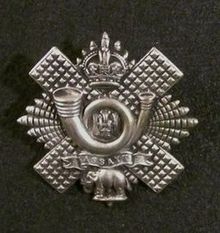Highland Light Infantry
| Highland Light Infantry | |
|---|---|

Cap Badge of the Highland Light Infantry
|
|
| Active | 1881–1959 |
| Country |
|
| Branch |
|
| Type | Infantry |
| Role | Light infantry |
| Part of | Highland Brigade |
| Garrison/HQ |
Hamilton Barracks (1881–1921) Maryhill Barracks, Glasgow (1921–1959) |
| Nickname(s) | "Hell's Last Issue" The regiment was nicknamed 'The Glesga Keelies' during the Peninsular Wars. |
| March | Quick- The Bugle Horn |
| Mascot(s) | Elephant |
| Anniversaries | Assaye (September 23) |
| Insignia | |
| Hackle | White over Red |
| Tartan | MacKenzie Tartan |
The Highland Light Infantry was a light infantry regiment of the British Army formed in 1881. It took part in the First and Second World Wars, until it was amalgamated with the Royal Scots Fusiliers in 1959 to form the Royal Highland Fusiliers (Princess Margaret's Own Glasgow and Ayrshire Regiment) which later merged with the Royal Scots Borderers, the Black Watch (Royal Highland Regiment), the Highlanders (Seaforth, Gordons and Camerons) and the Argyll and Sutherland Highlanders to form the Royal Regiment of Scotland, becoming the 2nd Battalion of the new regiment.
The regiment was formed as part of the Childers Reforms on 1 July 1881 by the amalgamation of the 71st (Highland) Light Infantry (as the 1st Battalion) and the 74th (Highland) Regiment of Foot (as the 2nd Battalion) as the city regiment of Glasgow, absorbing local Militia and Rifle Volunteer units. Its exact status was ambiguous: although the regiment insisted on being classified as a non-kilted Highland regiment it recruited mainly from Glasgow in Lowland Scotland.
The 2nd Battalion saw action at the Battle of Tell El Kebir in September 1882 during the Anglo-Egyptian War: Lieutenant William Edwards was awarded the Victoria Cross for his actions during the battle. The battalion was stationed in England from 1883, but moved to India the following year. In February 1900 it departed from Colombo to return home.
...
Wikipedia
